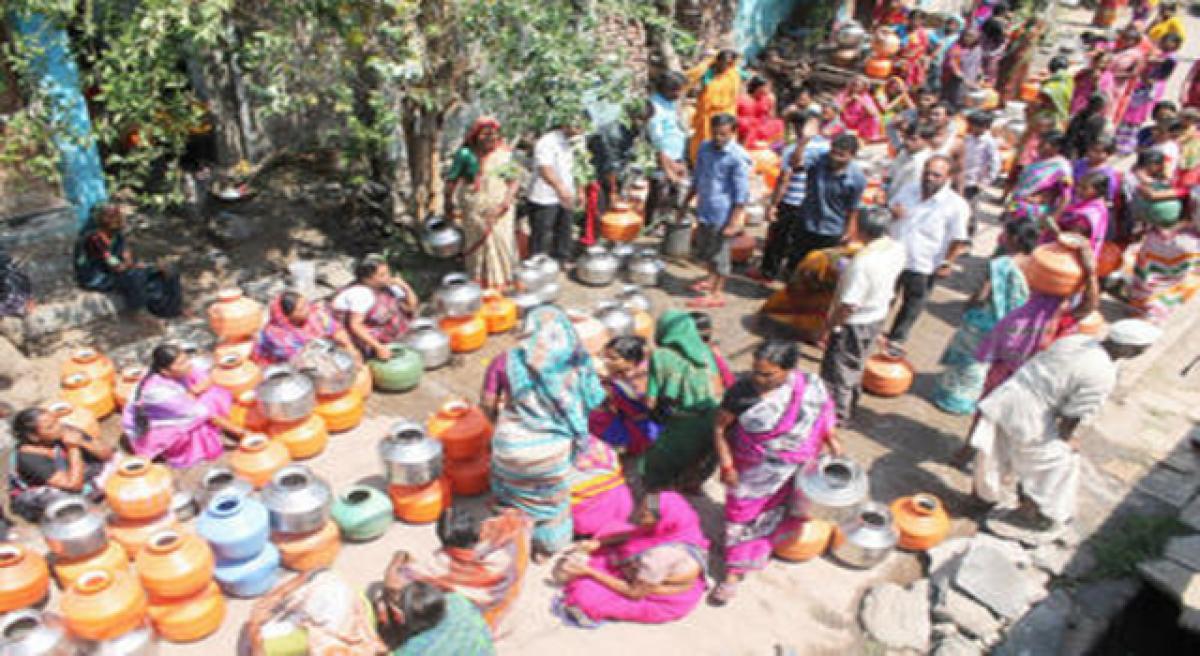Live
- Tight security arrangements at Group-II examination centers District SP
- Alia Bhatt captures attention in white
- Varun Dhawan talks about ‘Baby John’
- ‘Moonwalk’ trailer promises a quirky heist, love, and loyalty
- Combat leaf spot disease
- Ahsaas Channaopens up about her complex character in ‘Mismatched 3’
- Radhika Apte welcomes first child, shares heartfelt post
- Jacqueline dazzles at Da-Bangg Reloaded concert
- Time to boost measures to prevent drowning, save children: WHO
- TDP achieves milestone with 73 lakhs membership registration, says Chandrababu
Just In

Kotanka village with a population of 2,500 and 630 families was at one time in a precarious state with half of their borewells totally dried up and 200 borewells were giving poor yields due to the depletion of ground water to alarming levels.
Garladinne (Anantapur): Kotanka village with a population of 2,500 and 630 families was at one time in a precarious state with half of their borewells totally dried up and 200 borewells were giving poor yields due to the depletion of ground water to alarming levels.
This resulted in axing of more than 500 sweet orange trees and the village population struggling to get a pot of drinking water even for each household.
The village was declared as water scarce area and drilling of new borewells was completely prohibited by the state government. Out of 370 borewells, 182 were gone dry and remaining were giving poor yields as of December 2011.
However, the village today is teeming with life, thanks to the ‘Community Based Sustainable Ground Water Management’ project funded by European Union and ‘Bread For the World’ international agencies and implemented by Hyderabad based Centre for Water Studies(CWS) through RIDS, an NGO based in Anantapur which is working with the village people at the ground level.
Speaking to The Hans India, RIDS Project Director V Kistappa says that the people had their own inhibitions when they were approached by the NGO on the groundwater recharge project.
The village elders, sarpanch and all stake holders were taken into confidence and one borewell selected and recharged through this technology. He stated recharge impact was clearly seen on surrounding another five borewells and yields got improved.
Subsequently, 15 borewell recharge structures were constructed in the village and the dry borewells number got reduced to 96 by June 2014. Now, the drinking water crisis was completely solved, and all households are getting sufficient water.
This village was promoted as one of the model village to surrounding villages and they are visiting and encouraged by the measures they took for water conservation. CWS Executive Director Ram Mohan told The Hans India that the groundwaters which were in their rock bottom levels a couple of years ago have today sufficient water for every household apart from water for animals.
Water cisterns were set up at different points in the village for the benefit of animals and even for birds. Seven mini water tanks were installed, 3 single phase motors were fixed and a 250-metre pipeline was laid connecting water sources to households.
Besides, 2 RO water plants were set up and 20 litres of drinking water was being supplied every day to 634 families. Drip irrigation was organised for crops with 72 per cent subsidy covering 35,000 acres of agriculture and horticulture lands. Capacitors were fixed to pumpsets to make them energy efficient. Solar street lighting was installed especially at the water tanks for hassle-free operation.
A village committee had been constituted with 11 members representing all communities under the chairmanship of Ramalinga Reddy. The committee also established a MACS Society for lending micro-loans and encourage thrift. As many as 85 farm ponds were also dug in the village as part of measures for recharging of groundwater sources.
The committee is working in coordination with Sarpanch Peddakka. Every day, 450 labourers go for NREGS work, the highest in the mandal. All the local programmes were being coordinated by Suresh Naidu. RIDS is also doing a similar work along with CWS at Masakavankapalli village in Nallamada mandal, which is one of the over exploited villages in the Anantapur district on the water resources front.
Village committee chairman Ramalinga Reddy says that he never imagined that unity in the village could pay such rich dividends, thanks to the initiative of RIDS and CWS in this regard.
By Ravi P Benjamin

© 2024 Hyderabad Media House Limited/The Hans India. All rights reserved. Powered by hocalwire.com







